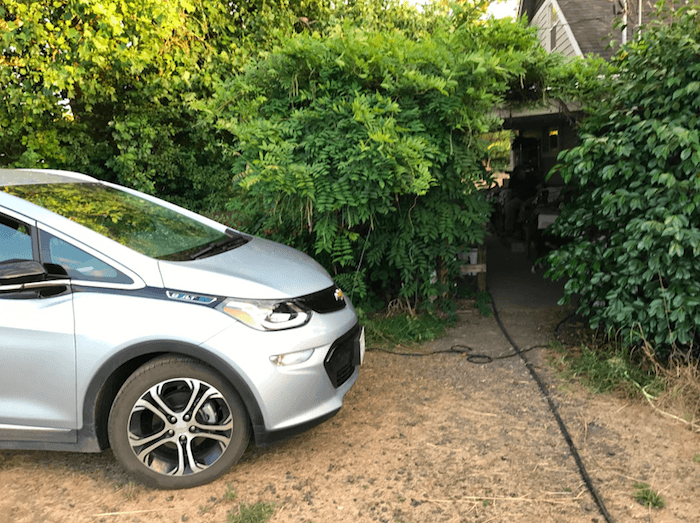Sonoma Ecology Center Executive Director Richard Dale and his family are enjoying a road trip to British Columbia – and they’re making the drive in their all-electric Chevrolet Bolt EV. What follows is part two of Richard’s chronicle of the highs and lows of taking the Electric Highway from Sonoma to British Columbia. (Click here to read part one.)
By Richard Dale
Days 2-3. June 30 to July 1 – Ashland
We stayed with a friend while in Ashland, and hooked up the Bolt to a 110-volt source near her driveway. (We’d brought a portable, 15-amp, level 2 charger and a 25-foot extension cord that could also use normal electrical outlets in a pinch. But her 220-volt power source turned out to be in another building behind the house, so we resorted to the 110-volt source.) In the morning, 10 hours later, we’d gained only 30 miles of charge, so we knew we needed an alternative.
We went exploring and discovered that, while chargers in the touristy downtown area of Ashland could be busy, chargers out a bit at Southern Oregon University were virtually unused. Apparently, when the town’s renowned Shakespeare Festival was in high season and parking there was at a premium, the university was mostly on break. We connected to a ChargePoint free charger in an empty lot that turned out to be about four blocks from our friend’s house, and walked back. We saw a street-side rack of rental bikes along the way, and noted that if one wanted to get around while a vehicle was charging for a few hours, that person could rent a bike for a few dollars and ride into town. We instead used our friend’s.
After riding around town and its famous Lithia Park, and up to a local reservoir to swim, the car was fully charged and ready for the next leg of our adventure.
This turned out to be something different than we’d thought. The next day we ran into another friend who suggested an interesting hike in the new National Monument east of Ashland, and we took the EV up into those mountains for a bit of off-pavement exploring. The hike was great, we impressed our friend with the EV, and later had no trouble picking up the few miles we’d used on a free charger in the downtown area while we went to dinner and the theater. That seemed pretty cool.
Day 4. July 2 – Ashland to Eugene
The next day was a travel day. We had about 185 miles to a friend’s ranch outside of Eugene, Oregon, and drove up Interstate 5 a bit more cautiously than we would have in an ICE car. We made it with no issues and with 50 miles to spare. The route in Southern Oregon is hilly and windy, but traffic moves more slowly than in the part of California’s Central Valley we’d travelled earlier, and downhill sections regenerate power and seem to make up for the extra power used going uphill.
Our friend near Eugene had a place where we could plug our portable charger into a dryer outlet near the driveway, and the Bolt fully charged up overnight. It was a plus that our charging station came with a ranch that was home to an unusual breed of horses, Akhal-Teke, including a 16-day-old foal that was about as cute as can be.
It’s worth noting that there are several level 2 chargers but no CCS fast chargers in the Eugene area. Cottage Grove, about 15 miles south, has a “half-fast” 24kWh charger. Forty-eight miles north in Albany there are two 24kWh chargers, and 21 miles beyond in Salem, there’s a 50 kWh fast charger at Roth’s Market.
Day 5. July 3 – Eugene to Seattle
After a very nice if too short visit, we headed out onto the Electric Highway again. We arrived in Portland in the early afternoon, at a WalMart shopping center on the north end of the city near the Washington state border that was home to one of a number of fast chargers in the area. Again, the parking lot around the charger was deserted, and we connected to the 50kW charger with no problem, and wandered off to a nearby park for a picnic lunch. After lunch we found a path that took us over to a side channel of the Columbia River and watched birds, people, and a lot of new riverfront construction.
We also wandered by an apartment area with lots of peat-like bark in its landscaping that we discovered was flammable– someone had tossed a lit cigarette butt onto it, and partly under the surface, a ring of smoldering fire was slowly spreading outward. We found a neighbor with a bucket and helped him douse it before the dry grass next to their apartments caught fire.
When we got back to the car a bit later than expected, we found, annoyingly, that the EVgo charger had turned itself off at 80 percent charge, and had not alerted us by text that the charge was over, as they often do. We started the charger again, and it took another 35 minutes. Again, the charge rate on a fast charger slows down as an EV gets close to a full charge. That put us squarely into Fourth of July eve traffic. Still, once we were over the river and out of Oregon, the traffic moved normally. We drove 175 miles to Seattle with little issue, at 60 to 65 miles per hour with the traffic, and had 40 miles of charge left as we arrived at our friend’s place.
Click here to read Traveling the Electric Highway: Part III

